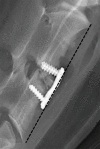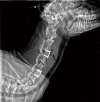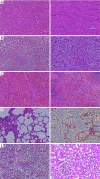Bioabsorbable high-purity magnesium interbody cage: degradation, interbody fusion, and biocompatibility from a goat cervical spine model
- PMID: 33145273
- PMCID: PMC7575937
- DOI: 10.21037/atm-20-225
Bioabsorbable high-purity magnesium interbody cage: degradation, interbody fusion, and biocompatibility from a goat cervical spine model
Abstract
Background: Bioabsorbable Mg-based implants have been a focus of orthopedic researches due to their intrinsic advantages in orthopedics surgeries. This study aimed to investigate the performance of bioabsorbable high-purity magnesium (HP Mg, 99.98 wt.%) interbody cages in anterior cervical discectomy and fusion (ACDF) and to evaluate the degradation of HP Mg cages under an interbody microenvironment.
Methods: ACDF was performed at C2-3 and C4-5, and a HP Mg cage or autologous iliac bone was randomly implanted. At 3, 6, 12 and 24 weeks after surgery, the cervical specimens were harvested to evaluate the fusion status, degradation and biocompatibility by CT, micro-CT, histological examinations and blood tests.
Results: There was no significant difference in the CT fusion score between cage group and autogenous ilium group at 3 and 6 weeks. At 12 and 24 weeks, the mean CT fusion score in the cage group was markedly lower than in the autogenous ilium group. CT and histological examinations showed bony junctions formed through the middle hole of the cage between upper and lower vertebral bodies in the cage group, but the total fusion area was less than 30%. The degradation rate of cages was relatively rapid within the first 3 weeks and thereafter became stable and slow gradually. The HP Mg cage had good biosecurity and biomechanical characteristics.
Conclusions: Implantation of Mg-based interbody cage achieves successful histological fusion, while the total fusion area needs to be improved. More studies are needed to improve the bone-cage interface.
Keywords: Anterior cervical discectomy and fusion (ACDF); bioabsorbable interbody cage; high-purity magnesium (HP Mg).
2020 Annals of Translational Medicine. All rights reserved.
Conflict of interest statement
Conflicts of Interest: All authors have completed the ICMJE uniform disclosure form (available at http://dx.doi.org/10.21037/atm-20-225). The authors have no conflicts of interest to declare.
Figures










Similar articles
-
Biomechanical comparison of bioabsorbable cervical spine interbody fusion cages.Spine (Phila Pa 1976). 2004 Aug 15;29(16):1717-22. doi: 10.1097/01.brs.0000134565.17078.4c. Spine (Phila Pa 1976). 2004. PMID: 15303013
-
Evaluation of a Porous Bioabsorbable Interbody Mg-Zn Alloy Cage in a Goat Cervical Spine Model.Biomed Res Int. 2018 Nov 25;2018:7961509. doi: 10.1155/2018/7961509. eCollection 2018. Biomed Res Int. 2018. PMID: 30596099 Free PMC article.
-
Evaluation of bioabsorbable multiamino acid copolymer/α-tri-calcium phosphate interbody fusion cages in a goat model.Spine (Phila Pa 1976). 2011 Dec 1;36(25):E1615-22. doi: 10.1097/BRS.0b013e318210ca32. Spine (Phila Pa 1976). 2011. PMID: 21270683
-
Bioabsorbable interbody magnesium-polymer cage: degradation kinetics, biomechanical stiffness, and histological findings from an ovine cervical spine fusion model.Spine (Phila Pa 1976). 2014 Sep 15;39(20):E1220-7. doi: 10.1097/BRS.0000000000000507. Spine (Phila Pa 1976). 2014. PMID: 25010099
-
An overview of magnesium-based implants in orthopaedics and a prospect of its application in spine fusion.Bioact Mater. 2024 May 30;39:456-478. doi: 10.1016/j.bioactmat.2024.04.026. eCollection 2024 Sep. Bioact Mater. 2024. PMID: 38873086 Free PMC article. Review.
Cited by
-
Advancements in biomaterials and bioactive solutions for lumbar spine fusion cages: Current trends and future perspectives.Bioact Mater. 2025 Jul 31;53:656-703. doi: 10.1016/j.bioactmat.2025.07.035. eCollection 2025 Nov. Bioact Mater. 2025. PMID: 40792114 Free PMC article. Review.
-
Magnesium-based alloys with adapted interfaces for bone implants and tissue engineering.Regen Biomater. 2023 Nov 1;10:rbad095. doi: 10.1093/rb/rbad095. eCollection 2023. Regen Biomater. 2023. PMID: 38020233 Free PMC article. Review.
-
Preliminary results in anterior cervical discectomy and fusion with the uncovertebral joint fusion cage in a goat model.BMC Musculoskelet Disord. 2021 Jul 17;22(1):628. doi: 10.1186/s12891-021-04412-4. BMC Musculoskelet Disord. 2021. PMID: 34273965 Free PMC article.
-
Biomechanical analysis of a newly designed and 3D printed plate-locking interbody cage: an observational study of finite element analysis.Sci Rep. 2025 Jan 28;15(1):3534. doi: 10.1038/s41598-025-88151-9. Sci Rep. 2025. PMID: 39875489 Free PMC article.
-
Rotator cuff repair with biodegradable high-purity magnesium suture anchor in sheep model.J Orthop Translat. 2022 Sep 10;35:62-71. doi: 10.1016/j.jot.2022.07.008. eCollection 2022 Jul. J Orthop Translat. 2022. PMID: 36186661 Free PMC article.
References
LinkOut - more resources
Full Text Sources
Research Materials
Miscellaneous
